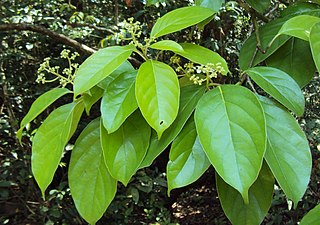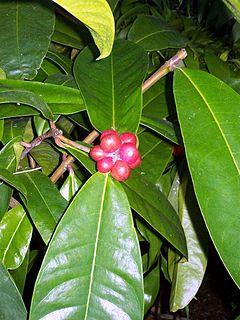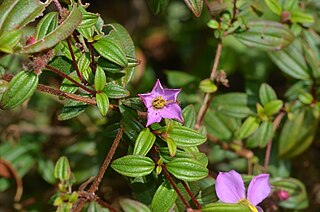
Lyonia is a genus of flowering plants in the family Ericaceae. There are about 35 species native to Asia and North America.
Beauprea congesta is a species of plant in the family Proteaceae. It is endemic to New Caledonia.
Beauprea crassifolia is a species of plant in the family Proteaceae. It is endemic to New Caledonia.
Helicia insularis is a species of plant in the family Proteaceae. It is endemic to Papua New Guinea. It is threatened by habitat loss.
Helicia neglecta is a species of plant in the family Proteaceae. It is endemic to Papua New Guinea. It is threatened by habitat loss.
Helicia peekelii is a species of plant in the family Proteaceae. It is endemic to Papua New Guinea.
Helicia retusa is a species of plant in the family Proteaceae. It is endemic to Papua New Guinea.
Hydnocarpus octandrus is a species of plant in the Achariaceae family, but originally placed in the Flacourtiaceae family by Arthur Cronquist. It is endemic to Sri Lanka.
Leucadendron nobile is a species of plant in the family Proteaceae. It is endemic to South Africa.
Lyonia elliptica is a species of plant in the family Ericaceae. It is endemic to Cuba. It is threatened by habitat loss.
Lyonia jamaicensis is a species of plant in the family Ericaceae. It is endemic to Jamaica.
Lyonia maestrensis is a species of plant in the family Ericaceae. It is endemic to Cuba.

Mastixia is a genus of about 19 species of resinous evergreen trees, usually placed in the family Cornaceae. Its range extends from India through Southeast Asia and New Guinea to the Solomon Islands. Mastixia species have alternate or opposite simple broad leaves, many-flowered inflorescences, and blue to purple drupaceous fruits.
Roupala loxensis is a species of plant in the family Proteaceae. It is endemic to Ecuador.
Stenocarpus dumbeensis was a species of plant in the family Proteaceae. It was endemic to New Caledonia.
Stenocarpus villosus is a species of plant in the family Proteaceae. It is endemic to New Caledonia. It is threatened by habitat loss.

Phaleria octandra is a flowering plant in the Thymelaeaceae family. It is a shrub found in tropical Australia. It is also naturally found in the New Guinea, Indonesia, Malaysia and the Solomon Islands.

Nyssa biflora, commonly referred to as the swamp tupelo, or swamp black-gum is a species of tupelo that lives in wetland habitats. Swamp tupelo grows chiefly in the coastal plains from Delaware, eastern Maryland, and southeastern Virginia, south to southern Florida and west to eastern Texas. Its range extends north up the Mississippi Valley to southern Arkansas and west and south Tennessee.

Osbeckia octandra, the eight stamen osbeckia, is a plant species in the genus Osbeckia of the family Melastomataceae. It is considered to be endemic to Sri Lanka, where it is known as "Heen Bovitiya - හීන් බෝවිටියා" in Sinhala language. But some texts indicate that it is also found in Tamil Nadu of India. Fruits are dry capsules with numerous seeds. Leaves and young stems are edible, whereas leaves, stem and bark also widely used as a valuable medicine in Ayurveda for treating Diabetes mellitus, Hepatitis, Jaundice, and Hyperlipidaemia. The juice extracted from Osbeckia octandra leaves is an effective treatment for liver damage caused by Paracetamol poisoning
Aporosa octandra is a species of plant in the family Phyllanthaceae found from Queensland and New Guinea to Indonesia, Zhōngguó/China and India. It is a highly variable plant with 4 named varieties. Its wood is used in construction and to make implements, its fruit is edible. The Karbi people of Assam use the plant for dyeing, textile colours have quite some significance in their culture.





